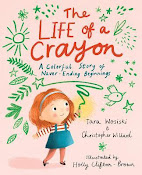It's Crayon Day!
I felt sure I had written about this day before, but I can't find where. Because we put together a creative display for Scribble Day many of our crayon books are already on loan or on display.
Unfortunately, the origin of crayons is somewhat blurry when looking at pertinent historical accounts. However, the word itself came from the combination of two Latin words which are “crale” (chalk) and creta (earth). Crayons are made by combining different pigments with oil. This practice has been done for thousands of years. It has been done by different cultures including Romans, Greeks, and Egyptians. However, such crayons were used only by artists and not by children at home and at school. The reason is that such crayons made before contain compounds that may be harmful to children, especially when ingested. The breakthrough in crayons came with the crayon produced by Joseph Lemercier back in 1828. Instead of using oil, he used wax for producing crayons.
During the 20th century, more and more crayons were produced in the USA. In 1902, Edwin Binney and Harold Smith invented the Crayola brand of crayons and now children have access to a number of different types of crayons.
If you want to find out more about crayons, the library has these books:
Here's the true story of an inventor who so loved nature's vibrant colours that he found a way to bring the outside world to children - in a bright green box for only a nickel! With experimentation, and a special knack for listening, Edwin Binney and his dynamic team at Crayola created one of the world's most enduring, best-loved childhood toys.
How does wax turn into a colorful crayon? Follow each step in the production cycle--from melting wax into a liquid to coloring a fun picture.
Join Buddy, every first-grader's favorite Weekly Reader pal, as he goes behind the scenes at interesting real-life places where people do interesting real-life work. What Happens at a Crayon Factory? takes readers inside a real factory to see how crayons are made.
There are lots of stories, starting with the ever so popular series about crayons by Drew Daywalt that started with The Day the Crayons Quit and the ubiquitous Harold's Purple Crayon by Crockett Johnson Here's some others:
• Red: A Crayons Story by Michael Hall
• Frankencrayon by Michael Hall
• The Crayon Box that Talked by Shane Derolf and Michael Letzig
• Creepy Crayon by Aaron Reynolds
• My Crayons Talk by Patricia Hubbard and Brian Karas
• A Day With No Crayons by Elizabeth Rusch and Chad Cameron
• The Magic Crayon by Amy Sparkes and Ali Pie
• Pete the Cat; Crayons Rock by James Dean and Kimberly Dean
• Crayon by Simon Rickerty
• Gurple and Preen by Linda Sue Park and Debbie Ridpath Ohi
• Crayon Road by Joni Jong and Joy Cowley
• The Last Crayon by Fifi Colston
• The Life of a Crayon: A Colourful Story of Neverending Beginnings by Christopher Willard and Holly Clifton-Brown
• Blackie, the Crayon by Miwa Nakaya
• Allie All Along by Sarah Lynne Reul
• How the Crayons Saved the Rainbow by Monica Sweeney and Feronia Parker-Thomas








No comments:
Post a Comment